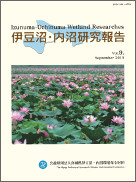Volume 9
Displaying 1-7 of 7 articles from this issue
- |<
- <
- 1
- >
- >|
-
2015 Volume 9 Pages 1-12
Published: 2015
Released on J-STAGE: November 10, 2017
Download PDF (730K) -
2015 Volume 9 Pages 13-22
Published: 2015
Released on J-STAGE: November 10, 2017
Download PDF (642K) -
2015 Volume 9 Pages 23-33
Published: 2015
Released on J-STAGE: November 10, 2017
Download PDF (955K) -
2015 Volume 9 Pages 35-46
Published: 2015
Released on J-STAGE: November 10, 2017
Download PDF (962K) -
2015 Volume 9 Pages 47-60
Published: 2015
Released on J-STAGE: November 10, 2017
Download PDF (1069K) -
2015 Volume 9 Pages 61-70
Published: 2015
Released on J-STAGE: November 10, 2017
Download PDF (993K) -
2015 Volume 9 Pages 71-73
Published: 2015
Released on J-STAGE: November 10, 2017
Download PDF (298K)
- |<
- <
- 1
- >
- >|
